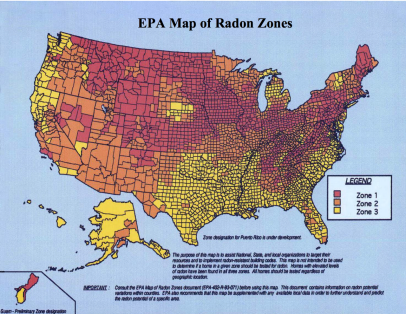RADON ASSESSMENT AT NAVAL SUPPORT ACTIVITY WASHINGTON
Update: We have completed our initiative to conduct Radon monitoring at multiple NSA Washington bases during the past year. The approximately 2,000 radon radon detectors placed throughout NSA Washington buildings last year have been collected and sent to an approved laboratory for analysis. We have now received results for NSF Arlington, NSF Carderock, NSF Naval Observatory and NSF Suitland.
Background: Throughout 2017 and 2018, an assessment will be conducted to determine indoor radon gas levels at selected locations within Naval Support Activity Washington. This assessment is being conducted as a routine task here at NSAW as well as other Naval Installations service wide and at other facilities of the Armed Forces.
The selected locations include:
-Naval Support Facility (NSF) Arlington
-NSF Carderock
-NSF Naval Observatory
-NSF Suitland
-Washington Navy Yard (WNY)
The assessment is not being conducted because of a known concern, but rather as a proactive step to ensure our service members and employees live and work in a healthy environment.
If elevated levels of radon are found, steps will be taken to formulate a plan for corrective action.
We ask for cooperation from everyone in making sure the test devices are not disturbed throughout the required full year they will be in place.
NSAW Radon POC: (202) 433-0154
NSF Arlington Radon Results 2017-2018 Radon Survey
NSF Naval Observatory Updated Radon Results 2017-2018 Radon Survey
NSF Naval Observatory Radon Results 2017-2018 Radon Survey
NSF Carderock Updated Radon Results 2017-2018 Radon Survey
NSF Carderock Radon Results 2017-2018 Radon Survey
NSF Suitland Radon Results 2017-2018 Radon Survey
Washington Navy Yard Radon Results 2017-2018 Radon Survey
NSAW Radon Detector Collection
NSAW Radon Fact Sheet
NSAW Radon Assessment FAQs
What is Radon?
Radon is a naturally occurring gas that comes from the breakdown of minerals found in certain geologies. It is not because of any man-made pollution, such as landfills or illegal dumping, but rather natural occurring radon.
What does Radon do to me?
Exposure to elevated levels of radon over extended periods of time can increase the potential for lung cancer. This is why the U.S. Navy is taking steps to identify potential concerns.
Is Radon only a Problem at NSAW?
No, radon can be present in any structure that is constructed over radon producing soils or geologies. Personal residence can be of particular concern, especially with the amount of time that you and your family members spend there. That is why the U.S. EPA as well as many state agencies recommends that all homeowners and schools test for radon.
The map below was developed by the U.S. Geological Survey and the U.S. EPA, and depicts high radon potential areas across the country (shown in red). As illustrated by the map, elevated indoor radon can occur in many more areas than Bethesda. However, the area within Montgomery County is known to have a high frequency of elevated levels of radon in homes. It is highly recommended that in addition to this survey, that you test your own home. To learn more about radon and how you can test your own home, see the links at the bottom of this page.
 Source: U.S. Geological Survey & U.S. EPA
Source: U.S. Geological Survey & U.S. EPA
 Above is an image of the radon assessment devices that will be deployed throughout NSAW buildings. These devices are extremely sensitive and should not be touched, moved, or placed in close proximity to fans or open windows.
Above is an image of the radon assessment devices that will be deployed throughout NSAW buildings. These devices are extremely sensitive and should not be touched, moved, or placed in close proximity to fans or open windows.
Key Things to Remember about the Survey:
- The devices will be attached to walls, bookcases.
- They will be in place for one year.
- Because radon comes from the ground, only lower portions of a selected building will be tested.
- They pose no health risk and do not contain electronic recording instrumentation of any kind.
- Please do not disturb the devices.
Additional Information:
To learn more about radon and how to take steps to assure a safe environment in your own home, please visit the following websites:
- U.S. EPA Radon Website Information about radon, how to test for it, and how to reduce radon in your home.
- U.S. EPA - Citizen's Guide to Radon Discusses the potential health risks of prolonged radon exposure.
- U.S. EPA - Consumer's Guide to Radon How radon can be easily reduced.
- National Radon Program Services Obtain a test kit for measuring the radon exposure in your home.
- Maryland Department of Health Radon Page Obtain a test kit to determine radon exposures in your home.
- Radon in Montgomery County Information and resources related to radon for the state of Maryland.
- Radon in Washington, D.C. Information and resources related to radon in Washington, D.C.